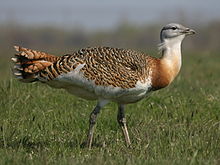Columbaves
| Columbaves Temporal range:
| |
|---|---|

| |
| Rock Pigeon (Columba livia) | |

| |
| Great Bustard (Otis tarda) | |
| Scientific classification | |
| Domain: | Eukaryota |
| Kingdom: | Animalia |
| Phylum: | Chordata |
| Class: | Aves |
| Clade: | Neoaves |
| Clade: | Columbaves Prum et al., 2015 |
| Clades | |
Columbaves is a clade that contains Columbimorphae (pigeons, mesites, and sandgrouse) and Otidimorphae (bustards, cuckoos, and turacos) discovered by genomic analysis by Prum et al. (2015).[1] This conflicts with the Columbea and Otidae hypotheses which Mirandornithes are the sister taxon to Columbimorphae and Cypselomorphae the sister taxon to Otidimorphae, respectively, found by Jarvis et al. (2014).[2] Neither hypothesis supports the two subdivisions of Metaves and Coronoaves as previous studies had found.[3][4]
| Columbaves |
| ||||||||||||||||||||||||||||||
In 2020 Kuhl et al. sequenced 3-prime untranslated region (3’UTR) from 429 species and 379 genera of birds found support of Columbaves in their study. However they have found that cuckoos are the sister group to pigeons within Columbimorphae instead as shown in the cladogram below:[5]
| Columbaves |
| ||||||||||||||||||||||||||||||
See also
[edit]References
[edit]- ^ Prum, R. O. et al. A comprehensive phylogeny of birds (Aves) using targeted next-generation DNA sequencing. Nature (2015). doi:10.1038/nature15697
- ^ Jarvis, E.D.; et al. (2014). "Whole-genome analyses resolve early branches in the tree of life of modern birds". Science. 346 (6215): 1320–1331. Bibcode:2014Sci...346.1320J. doi:10.1126/science.1253451. PMC 4405904. PMID 25504713.
- ^ Ericson, P. G.P; Anderson, C. L; Britton, T.; Elzanowski, A.; Johansson, U. S; Kallersjo, M.; Ohlson, J. I; Parsons, T. J; Zuccon, D.; Mayr, G. (2006). "Diversification of Neoaves: integration of molecular sequence data and fossils". Biology Letters. 2 (4): 543–547. doi:10.1098/rsbl.2006.0523. PMC 1834003. PMID 17148284.
- ^ Hackett, S. J.; Kimball, R. T.; Reddy, S.; et al. (2008). "A Phylogenomic Study of Birds Reveals Their Evolutionary History" (PDF). Science. 320 (5884): 1763–1768. Bibcode:2008Sci...320.1763H. doi:10.1126/science.1157704. PMID 18583609. S2CID 6472805.
- ^ Kuhl., H.; Frankl-Vilches, C.; Bakker, A.; Mayr, G.; Nikolaus, G.; Boerno, S. T.; Klages, S.; Timmermann, B.; Gahr, M. (2020). "An unbiased molecular approach using 3'UTRs resolves the avian family-level tree of life". Molecular Biology and Evolution. 38: 108–127. doi:10.1093/molbev/msaa191. PMC 7783168. PMID 32781465.




